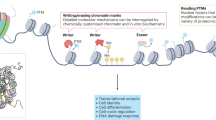Abstract
Histones package DNA into chromatin and regulate genes through a multitude of histone modifications. A ‘histone code’ hypothesis has been put forth that ascribes different patterns of histone modifications specific biological functions. This article highlights recent chemical biological approaches to uncover the complex cross-talk between histone marks and chromatin activity.
Similar content being viewed by others
Literatur
Turner BM (2001) Chromatin and Gene Regulation. Blackwell Science Ltd., Oxford
Allis CD, Muir TW (2011) Spreading chromatin into chemical biology. Chembiochem 12:264–279
Schwarzer D (2010) Chemical tools in chromatin research. J Pept Sci 16:530–537
Strahl BD, Allis CD (2000) The language of covalent histone modifications. Nature 403:41–45
Hackenberger CP, Schwarzer D (2008) Chemoselective ligation and modification strategies for peptides and proteins. Angew Chem Int Ed Engl 47:10030–10074
Dawson PE, Muir TW, Clark-Lewis I et al. (1994) Synthesis of proteins by native chemical ligation. Science 266:776–779
Piotukh K, Geltinger B, Heinrich N et al. (2011) Directed evolution of sortase A mutants with altered substrate selectivity profiles. J Am Chem Soc 133:17536–17539
Nikolov M, Stützer A, Mosch K et al. (2011) Chromatin affinity purification and quantitative mass spectrometry defining the interactome of histone modification patterns. Mol Cell Proteomics 10:M110.005371
Bartke T, Vermeulen M, Xhemalce B et al. (2011) Nucleosome-interacting proteins regulated by DNA and histone methylation. Cell 143:470–484
Shogren-Knaak M, Ishii H, Sun JM et al. (2006) Histone H4-K16 acetylation controls chromatin structure and protein interactions. Science 311:844–847
Fierz B, Chatterjee C, McGinty RK et al. (2011) Histone H2B ubiquitylation disrupts local and higher-order chromatin compaction. Nat Chem Biol 7:113–119
Taunton J, Hassig CA, Schreiber SL (1996) A mammalian histone deacetylase related to the yeast transcriptional regulator Rpd3p. Science 272:408–411
Author information
Authors and Affiliations
Corresponding author
Additional information
Dirk Schwarzer Jahrgang 1972. 1993–2002 Chemiestudium und Promotion an der Universität Marburg. 2003–2006 Postdoc an der Johns Hopkins University, Baltimore, MD, USA. 2006–2007 Postdoc an der Universität Dortmund. 2007–2011 Leiter einer Emmy-Noether-Gruppe am Leibniz-Institut für Molekulare Pharmakologie (FMP) in Berlin. Seit 2011 Professor für Biochemie am Interfakultären Institut für Biochemie, Universität Tübingen.
Rights and permissions
About this article
Cite this article
Schwarzer, D. Die Chemische Biologie beschreitet neue Wege in der Chromatinforschung. Biospektrum 18, 248–250 (2012). https://doi.org/10.1007/s12268-012-0169-9
Published:
Issue Date:
DOI: https://doi.org/10.1007/s12268-012-0169-9




